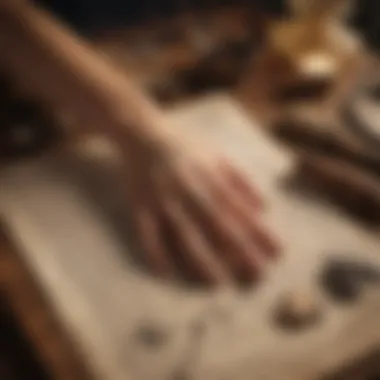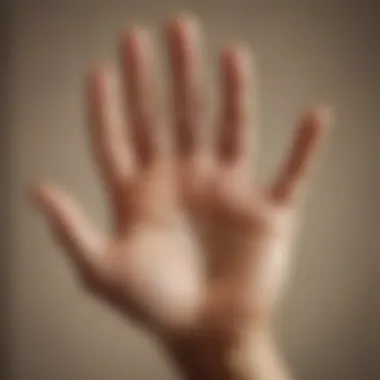Exploring Palmistry: Insights from a Digital Perspective


Intro
Palmistry, the art of interpreting the lines and shapes of the hands, holds a significant place in the realm of esoteric knowledge and personal insight. Its origins trace back thousands of years, spanning various cultures across the globe. In contemporary times, the practice has found a renewed interest, facilitated by digital platforms that have transformed how this ancient art is taught and understood. The intersection of palmistry and technology reveals much about our society’s evolving relationship with ancient wisdom and modern science.
Understanding palmistry requires not just an appreciation for its historical significance but also an awareness of how this knowledge is consumed and disseminated today. Digital resources, from online courses to social media discussions, create larger communities where enthusiasts can share insights and learn from one another. These connections bridge the gap between tradition and modernity, making palmistry more accessible than ever.
The allure of palmistry lies in its promise of self-discovery. Many individuals are drawn to this practice out of a desire to understand their personality, potential, and future. This article will explore how palmistry maintains its relevance in modern culture and how digital tools enhance this ancient practice. By examining key findings and implications of current research, we aim to shed light on how palmistry is perceived today and what its future might hold.
Prolusion to Palmistry
Palmistry offers a unique lens through which to understand human experiences and individual potential. This practice, which involves interpreting the features of the palm, serves as a bridge between ancient wisdom and contemporary insights. Exploring palmistry not only grants a deeper appreciation for its historical significance but also allows one to observe how modern interpretations breathe new life into this age-old practice. This section is essential for framing the subsequent discussions in the article and understanding the intersection of tradition and technology.
Definition and Overview
Palmistry, also known as chiromancy, is the art of interpreting the lines, shapes, and features of the hands, particularly the palms. It seeks to uncover insights about personality traits, potential future events, and emotional make-up. Practitioners study prominent lines such as the Heart Line, Head Line, and Life Line, alongside minor lines, mounts, and even the size or shape of fingers and nails. Each element conveys distinct meaning, creating a complex narrative that some individuals find enlightening.
In a nutshell, palmistry serves as a personal tool for self-reflection and growth, revealing underlying factors that may affect a person's life journey. This ancient practice remains relevant today, allowing individuals to seek answers and insights in an increasingly fast-paced world.
Historical Background
The roots of palmistry can be traced back thousands of years across various cultures. Evidence of its practice is found in ancient Indian texts, Greek philosophical works, and Chinese scripts. Historically, the earliest mentions appear in Hindu scriptures, where it was linked to spiritual beliefs. The Greeks, notably Aristotle, were also intrigued by palmistry, contributing to its intellectual exploration.
Throughout history, palmistry has evolved. In medieval Europe, it was often viewed with skepticism, linked to superstition and the arcane arts. However, by the 19th century, there was a resurgence of interest, aligning with movements such as Spiritualism. Figures like Cheiro gained fame for their celebrity palm readings, bridging the divide between mysticism and entertainment.
Cultural Significance
Palmistry transcends mere fortune-telling; it reflects the values and beliefs of diverse cultures. In India, for instance, it is still common for individuals to consult palmists for guidance in major life decisions, such as marriage. The Chinese perspective incorporates palmistry into traditional medicine, emphasizing harmony between the physical and spiritual aspects of life.
The significance of palmistry also manifests in modern contexts, where it serves as a form of self-discovery. In today's digital age, palmistry interfaces with culture through blogs, forums, and social media, where individuals share personal interpretations and stories. This blend highlights its adaptability, ensuring its relevance persists amidst changing societal landscapes.
"Palmistry, at its core, provides not only glimpses into the future but also reflections on personal identity, making it a unique blend of art and science."
Engaging with palmistry can foster a richer understanding of oneself, but also invites critical reflection on its role in contemporary society. As we move forward in the article, we will examine the scientific context of palmistry and its implications in the digital age.
The Science Behind Palmistry
The complexities of palmistry extend beyond mere observation of the lines and shapes of hands. The scientific lens allows us to understand palmistry through biological and psychological perspectives. This section will analyze how our biological composition influences the characteristics of our palms. Furthermore, we consider the psychological aspects that might impact individual interpretations of palmistry. Finally, we will address criticisms surrounding the practice, thus providing a candid assessment of palmistry's validity and relevance in contemporary society.
Biological Factors
When discussing the biological aspects of palmistry, it is essential to consider genetics and the human body's physiological traits. The hands, like all body parts, exhibit variations among individuals, influenced by genetics. Certain physical features can include the length of fingers, the shape of the palm, and the distinctiveness of the lines drawn upon it.
- Genetic predispositions may determine various qualities apparent in the hands.
- The skin texture and condition can reflect overall health, which some practitioners believe informs palmistry interpretations.
- Additionally, specific biological changes over time can cause modifications in hand lines, suggesting that palmistry can trace life’s journey.
Understanding these elements helps connect palmistry to human biology. This intersection allows for a more informed approach to interpretations based on physiological indicators.
Psychological Aspects
The role of psychology in palmistry cannot be overlooked. How individuals perceive their hands and the meanings they ascribe to them involves a subjective interpretation process. Cognitive biases and societal influences play a huge part in how palmistry is personally understood and accepted.
- Many people may project their desires or fears onto their readings, skewing the interpretation.
- The cultural context where one is raised often dictates the acceptability of palmistry and personal belief in its efficacy.
- A positive reading can lead to increased confidence and motivation, while negative interpretations might induce anxiety or self-doubt.
All these factors contribute to the psychological foundation of palmistry, making it not merely a physical practice but one deeply rooted in personal belief systems and mental states.
Limitations and Criticism
Despite its historical significance, palmistry faces significant criticism and challenges in its validity as a practice. Skeptics often cite the lack of empirical evidence supporting many interpretations in palmistry. They may argue that variations in hand features do not necessarily correlate with personal characteristics or future events.


- Critics highlight the pseudoscientific nature of palmistry, suggesting that it lacks rigorous research and fail the standards of scientific scrutiny.
- There are concerns regarding misrepresentation, where some practitioners can exploit people's vulnerabilities for personal gain.
- Finally, the ambiguity in interpreting the hand's lines creates room for manipulation and misdirection.
Examining these limitations helps foster a balanced viewpoint of palmistry, one that encompasses both its applications and shortcomings.
"Palmistry represents a fascinating blend of biology, psychology, and cultural perspectives that can enhance our understanding of human experiences but must be approached with a critical mind."
In summation, the science behind palmistry facilitates a deeper exploration of its nuances, highlighting biological, psychological, and critical perspectives. This analysis invites readers to understand the practice holistically and to reflect on its integration into modern society.
Palmistry Techniques
Understanding palmistry techniques is essential to appreciate the depth of this ancient practice. These techniques reveal insights about personality, potential life events, and interpersonal dynamics. They allow individuals to connect with the art of palm reading from a more educated and analytical perspective.
Reading the Major Lines
Heart Line
The heart line holds significant meaning in palmistry. It primarily relates to emotional aspects, such as love and relationships. The curve of the heart line can indicate openness to love and the presence of emotional richness in a person's life. This line is often a focal point for many readers because it reflects core emotional patterns.
The heart line is generally found at the top of the palm, and its shape can vary dramatically from person to person. When the line is long and deep, it signifies a capacity for strong emotional connections. However, a short or fragmented heart line may suggest difficulties in relationships or emotional expression. Knowing how to read this line supports a deeper understanding of personal connections and emotional health.
Head Line
The head line represents intellectual tendencies and decision-making processes. It usually runs horizontally across the palm. A long head line typically indicates a person who thinks deeply and is analytical. Conversely, a short head line may suggest a more pragmatic approach.
The way this line curves can also show how an individual approaches life's challenges. A straight head line may indicate straightforward thinking, while a wavy line suggests creativity and spontaneity. Recognizing the nuances of the head line enhances one's understanding of cognitive styles and problem-solving abilities.
Life Line
The life line is perhaps the most well-known aspect of palmistry. It encircles the base of the thumb, reflecting physical health and vitality. A deep and long life line often represents robust health and a strong zest for life, whereas a shallow line may indicate a more cautious approach to life.
Misunderstandings arise about the life line being indicative of lifespan. Rather, it signals quality of life and major life events. Therefore, analyzing this line is useful in understanding one’s potential for vitality and life experiences.
Interpreting Minor Lines
Fate Line
The fate line indicates life’s path and personal development. It varies widely among individuals, with some having little to no visible fate line. When present, a deep fate line suggests a strong connection to one’s destiny or career. Breaks or forks in this line may indicate changes or shifts in life direction.
This line aids readers in discussing how external circumstances may influence life changes. Understanding the fate line can highlight the interaction between free will and external influences.
Sun Line
Often linked to creativity and recognition, the sun line reveals aspects of fame and artistic talent. Its presence suggests a person may achieve success or recognition in their field. A strong sun line can indicate a vibrant personality with a knack for the arts.
On the other hand, a poorly defined sun line might reveal struggles with self-expression or a lack of recognition. Grasping the sun line's presence becomes significant when assessing one's creative potential.
Mercury Line
The mercury line relates to communication skills and business acumen. A strong mercury line suggests an affinity for speech and negotiation. Those with a well-defined mercury line may excel in writing or public speaking roles.
However, the absence of a strong mercury line can point to challenges in communication. This line's significance lies in understanding how communication can play a pivotal role in personal and professional settings.
Other Palm Features
Mounts
Mounts are the raised areas at the base of each finger on the palm. Each mount corresponds to different traits, such as ambition, creativity, or emotional intelligence. Analyzing these mounts provides a fuller picture of a person’s personality.


For example, a pronounced mount of Venus may indicate a warm-hearted and affectionate nature. Conversely, a flat mount could suggest a reserved personality. Understanding mount characteristics can enrich overall palm readings.
Fingers
Fingers themselves offer insight through their length, shape, and proportions. For instance, long fingers generally suggest adaptability and meticulousness, while short fingers can indicate decisiveness and confidence. Each finger’s alignment adds another layer to personality interpretation.
Recognizing the distinct features of fingers provides a clearer semantic understanding of behavioral tendencies and how a person might interact with the world around them.
Nails
Nail shapes and conditions can reveal much about an individual’s health and emotional state. For example, glossy and strong nails may indicate vitality, while brittle nails can point to underlying health concerns. Observing nails allows readers to dive into another aspect of a person's well-being.
Each of these palm features contributes to a holistic interpretation. Combining insights from major lines, minor lines, mounts, and fingers provides a comprehensive understanding of a palm reading.
Palmistry in the Digital Age
The discussion around palmistry today cannot be separated from its integration within the digital landscape. The advent of digital technology has revolutionized many ancient practices, and palmistry is no exception. The internet has significantly broadened access to information, resources, and communities, allowing individuals interested in palmistry to delve deeper into its study and practice. Understanding this transformation is essential for grasping the current state and future potential of palmistry.
The Role of Online Resources
In the current era, online resources serve as crucial tools for anyone wishing to explore palmistry. Websites, blogs, and forums offer a wealth of knowledge across varying levels of expertise. For beginners, basic tutorials and visual guides help in understanding fundamental concepts. More experienced practitioners can engage with in-depth analyses and scholarly articles that explore specific techniques or historical perspectives.
Moreover, community forums create opportunities for discussion and sharing experiences. Engaging with others enabled by platforms like Reddit or Facebook fosters a collaborative learning environment. Users can seek clarity on confusing aspects, share interpretations, and access diverse viewpoints. Access to this collective body of knowledge can transform the solitary practice of palmistry into a shared journey.
Mobile Applications and Tools
The rise of smartphones has also introduced a new dynamic to palmistry enthusiasts. Various mobile applications have been developed to assist users in their exploration of palmistry. These tools typically provide features such as image recognition, which allows users to photograph their palms and receive automated analyses. While some applications focus on providing general insights, others offer comprehensive breakdowns of various palm features, incorporating theories and interpretations from skilled practitioners.
In addition, apps often provide tutorials and guides that cover everything from the basics to advanced readings. They can also include journals for users to track their readings over time, which aids in personal reflection and growth. As technology continues to advance, the capabilities of these applications may expand, offering even more precise tools for the study of palmistry.
Educational Platforms and Community Sharing
With the rise of online learning, educational platforms are increasingly embracing palmistry. Courses offered on websites such as Udemy or Skillshare enable students to engage with the art form systematically. These courses often include video lectures, reading materials, and live interactions with instructors. Such structured learning can be more effective than self-study, providing a clearer framework and expert guidance.
Community sharing remains integral within these educational platforms. Students can interact with classmates, share findings, and exchange insights. This exchange enhances learning and encourages a sense of belonging among students who may otherwise feel isolated in their pursuit of palmistry.
"The digital era has democratized access to palmistry, making it possible for anyone, anywhere, to explore this ancient art with the help of online resources."
Ethical Considerations in Palmistry
Understanding ethical considerations in palmistry is essential, especially in a digital landscape. People engaging with palmistry may rely on insights and interpretations that are private and personal. Thus, a framework of ethics is necessary to safeguard the integrity of the practice and the individuals involved. In this section, we will explore the key aspects of consent, misrepresentation, and the balance of art and science in palmistry.
Consent and Privacy
Consent is a crucial element when engaging with palmistry. Practitioners must ensure that the individuals whose palms are being read are fully aware of the implications of sharing their personal information. Consent should not be merely implied; it needs to be explicit. This includes informing individuals about how their palm readings may be used, whether for commercial purposes, online sharing, or more personalized insights.
Privacy is intertwined with consent. Practicing palmistry can involve sensitive insights regarding a person’s life, including relationship dynamics, career paths, or health concerns. Unauthorized sharing of this information can harm trust and possibly lead to psychological distress. Therefore, practitioners must adhere to strict guidelines around privacy, guaranteeing the confidentiality of the readings and the individuals involved.
Misrepresentation and Misinformation
Misrepresentation in palmistry can take various forms. With the rise of online platforms, there is an increased risk of spreading misinformation. Not all content available on the internet is accurate. Some influencers or practitioners may exaggerate claims for commercial gain, exploiting the audience's trust. This can damage the credibility of palmistry as a practice.
It is essential for both practitioners and users to critically evaluate the sources from which they receive information. Authentic references, such as educational platforms or respected authors in the field, provide a more reliable basis for study. Additionally, the emergence of technology necessitates clear communication from practitioners regarding the limitations of their readings. Understanding that palmistry is an interpretative art rather than an exact science can help mitigate unrealistic expectations.
Balancing Art and Science
Finding a balance between the artistic and scientific elements of palmistry is vital. While palmistry has its roots in historical and cultural traditions, it should also consider empirical evidence and psychological insights. Practitioners must navigate the fine line between offering intuitive guidance and providing scientifically supported interpretations.


To achieve this balance, practitioners could integrate lessons from psychology about human behavior into their analysis. This adds depth to their readings and brings a more holistic view of the individual. Moreover, more researchers in this field could explore the scientific aspects of palmistry further, potentially lending legitimacy to the practice in contemporary discussions.
Ethical considerations in palmistry are not merely rules; they are foundational principles that uphold the trust and respect in a practice that carries personal significance.
Case Studies and Testimonials
The exploration of palmistry can often feel abstract, disconnected from tangible experiences. However, case studies and testimonials provide concrete evidence of its influence on lives and cultures. These narratives help to humanize the concepts discussed in previous sections. They illustrate how the practice of reading palms impacts personal decision-making and cultural interpretations. Understanding real-world applications can make palmistry more relatable and digestible for both students and professionals.
Influence on Personal Choices
Personal choices are steeped in the need for guidance, insight, and reassurance. Many individuals turn to palmistry when faced with significant life decisions. The lines on one's palm can be seen as a mirror reflecting underlying emotions and potential paths. Testimonials often reveal that people have used palm readings to help guide them through life transitions, such as career changes, relationships, and self-discovery.
For example, individuals frequently report feeling empowered after a reading, claiming that it provided clarity in uncertain times. Reads do not dictate future events, rather they serve as tools to foster introspection. This intersection between belief and choice encapsulates the core of palmistry’s appeal.
Cultural Perspectives on Palmistry
Cultural perceptions of palmistry vary widely. In some societies, it is seen as a respected art, akin to astrology or counseling. In others, it stands as a curiosity or even as skepticism prevails. These perspectives shape how palmistry is practiced and interpreted. For instance, in India, palmistry is deeply integrated into life choices, often influencing marital decisions and career paths.
Conversely, in Western contexts, palmistry may be less structured and more whimsical, potentially leading to varied interpretations based on individual practitioners. Case studies from diverse cultural backgrounds can shed light on these differences and highlight how beliefs about palmistry inform social norms and practices around it.
Historical Figures and Their Beliefs
The narratives of historical figures who engaged with palmistry add another layer of intrigue. Figures such as Aristotle and Leonardo da Vinci were known to explore this practice. Their contributions encapsulated a belief in the connection between hands and destiny. Such influential personalities lend credibility to palmistry as a subject worthy of exploration.
Many modern palmists trace their inspiration and methods back to these historical thinkers. This continuity highlights palmistry’s longstanding relevance. By examining biographical accounts, one gains insight into how these historical figures integrated palmistry into their worldview, thereby influencing others through their beliefs.
Future of Palmistry
The future of palmistry is a topic of great interest and importance as society continues to evolve. As this ancient practice intersects with modern technology, we can look forward to various transformations that will enhance its visibility and relevance. Understanding these changes is crucial for students, researchers, educators, and professionals who seek to explore palmistry in new contexts.
Integration with Technology
Technology plays a pivotal role in shaping the future of palmistry. Tools such as artificial intelligence and augmented reality can refine how readings are conducted and interpreted. For instance, AI algorithms might analyze a person’s palm and provide a detailed report based on established palmistry principles. Mobile applications could facilitate instant readings, making palmistry readily accessible to a broader audience.
These technologies can also elevate learning opportunities. Online platforms allow enthusiasts to connect globally, sharing insights and techniques. The democratization of information could lead to enhanced accuracy and understanding of this practice.
- Improved accessibility
- AI-enhanced analysis
- Global community connections
With these advancements, the essence of palmistry may shift but can still retain its rich heritage.
Research Opportunities
The integration of technology opens numerous avenues for research in palmistry. Scholars may investigate how digital tools influence the accuracy and perception of readings. This can lead to a clearer understanding of palmistry's scientific validity.
Additionally, studies could focus on how different cultures interpret palm lines and symbols differently within digital frameworks. By comparing these perspectives, researchers can contribute to a more inclusive view of palmistry.
Potential research areas include:
- Cross-cultural comparisons of palm interpretation
- The psychological impact of palm readings on individuals
- Technological impacts on traditional practices
Understanding these areas can provide a valuable foundation for developing modern palmistry practices.
Potential Challenges
While technology enhances palmistry's future, it is not without challenges. As new tools emerge, the risk of oversimplification or misinterpretation increases. Consumers may receive inaccurate readings due to reliance on apps that may not capture the nuances of a traditional reading.
Challenges to consider include:
- Quality control: Ensuring accuracy in automated readings
- Authenticity: Preserving the art and human connection in palmistry
- Ethical concerns: Misleading information or fraudulent practices
It is vital to address these challenges to maintain palmistry's integrity. Overall, the future of palmistry hinges on thoughtful integration of technology, leading to both opportunities and challenges that will shape its path forward.
The future of palmistry will be shaped by our ability to harmonize tradition with innovation.







